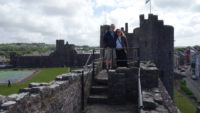 When it comes to touring, Meredith and I are … thorough. If time and energy allow, we see and read everything and listen to any docent we come across. Pembroke Castle’s website recommended leaving two hours to tour the castle. I figured we’d take four. We spent six hours there.
When it comes to touring, Meredith and I are … thorough. If time and energy allow, we see and read everything and listen to any docent we come across. Pembroke Castle’s website recommended leaving two hours to tour the castle. I figured we’d take four. We spent six hours there.
Whew, what a ton of history happened at and around this castle. In a nutshell, it all boils down to this:
It’s complicated.
The detailed version of the history is more involved, of course. It goes like this:
It’s complicated and involves a ton of people and time.
You can see why it took us six hours to tour the place.
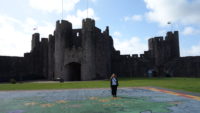 The interior of the castle is in excellent condition, with many structures intact and tourable. That includes the main round tower keep, for which, while you can’t go inside it for some reason (it had a barrier across the door), you can climb one hundred steps to the roof area, act terrified, take a couple of pictures, and flee back down one hundred steps. For instance.
The interior of the castle is in excellent condition, with many structures intact and tourable. That includes the main round tower keep, for which, while you can’t go inside it for some reason (it had a barrier across the door), you can climb one hundred steps to the roof area, act terrified, take a couple of pictures, and flee back down one hundred steps. For instance.
Several of the round towers had short films playing of the important people associated with the castle, the most famous of whom is Henry VII, of king fame. These little films were black and white cartoons which presented summaries of the history, but usually with some visual humor. Meredith and I laughed out loud at several points. We’ve seen several of these self-aware corny films at historical sights over the last two years, and we love them. I’m glad it seems to be a trend at tourist areas.
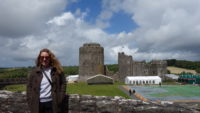 The castle dates from around 1090, which makes it old. The original one was made of wood and was built on an outcropping of one-hundred-foot cliff surrounded on three sides by a tidal river that rose and fell over twenty feet, either flooding the river area or leaving a large barrier of mud. As such, only the front of the castle really needed major defenses, which was a wall and a ditch originally, but was enough for forty Normans to hold off three Welsh princes and their army. It’s a superb defensive position, and the castle was never taken by force. It was surrendered to Cromwell after he finally brought in major siege guns, but those in the castle had held him off for eight weeks to that point.
The castle dates from around 1090, which makes it old. The original one was made of wood and was built on an outcropping of one-hundred-foot cliff surrounded on three sides by a tidal river that rose and fell over twenty feet, either flooding the river area or leaving a large barrier of mud. As such, only the front of the castle really needed major defenses, which was a wall and a ditch originally, but was enough for forty Normans to hold off three Welsh princes and their army. It’s a superb defensive position, and the castle was never taken by force. It was surrendered to Cromwell after he finally brought in major siege guns, but those in the castle had held him off for eight weeks to that point.
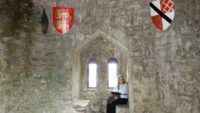 The wooden castle was eventually replaced in stages by stone, beginning in the 1100s. The major mover and shaker was William Marshal, who was a pre-Renaissance man. He came from nothing, trained as a knight for seven years, and then took the French knight tournaments by storm for ten years, beating almost five hundred combatants in that time. He became so famous that the English king, Henry II, called him back to England to train his sons. William Marshal married and advised his way up the feudal chain, becoming Earl of Pembroke and running England a couple of times for two of the kings he served (King Richard the Lionhearted, who was off fighting in the Crusades, and Henry III, who was just a boy when he became king). Marshal was also the key negotiator between King John and the barons when they were about to go to war, resulting in that Magna Carta thing about which we’ve heard so much and which is absolutely not in Lincoln Castle, where we successfully didn’t see it. Marshal also put down a rebellion in Lincoln when he was in his late sixties. Marshal lived a pretty amazing life and added huge expansion projects to Pembroke as a way to show off his success. Oh, and at the very end of his life (in his seventies), he managed to divorce his wife so that he could be buried as one of the Knights Templar, who required that the knights be chaste. Since he was divorced, he clearly wasn’t married, and so was chaste, and was buried as a Knight Templar. He was a well-known, powerful, and well-liked man.
The wooden castle was eventually replaced in stages by stone, beginning in the 1100s. The major mover and shaker was William Marshal, who was a pre-Renaissance man. He came from nothing, trained as a knight for seven years, and then took the French knight tournaments by storm for ten years, beating almost five hundred combatants in that time. He became so famous that the English king, Henry II, called him back to England to train his sons. William Marshal married and advised his way up the feudal chain, becoming Earl of Pembroke and running England a couple of times for two of the kings he served (King Richard the Lionhearted, who was off fighting in the Crusades, and Henry III, who was just a boy when he became king). Marshal was also the key negotiator between King John and the barons when they were about to go to war, resulting in that Magna Carta thing about which we’ve heard so much and which is absolutely not in Lincoln Castle, where we successfully didn’t see it. Marshal also put down a rebellion in Lincoln when he was in his late sixties. Marshal lived a pretty amazing life and added huge expansion projects to Pembroke as a way to show off his success. Oh, and at the very end of his life (in his seventies), he managed to divorce his wife so that he could be buried as one of the Knights Templar, who required that the knights be chaste. Since he was divorced, he clearly wasn’t married, and so was chaste, and was buried as a Knight Templar. He was a well-known, powerful, and well-liked man.
 Henry VII was born to his fourteen-year-old widowed mother in a tower in Pembroke Castle. It was during the Wars of the Roses, when two powerful families were killing each other for the right to be king, and Henry’s mother was part of that to the extent that they both had to flee to Brittany, in northern France. He eventually came back, raised an army, beat Richard III, became king, married a woman from the other house, and thus ended the Wars of the Roses.
Henry VII was born to his fourteen-year-old widowed mother in a tower in Pembroke Castle. It was during the Wars of the Roses, when two powerful families were killing each other for the right to be king, and Henry’s mother was part of that to the extent that they both had to flee to Brittany, in northern France. He eventually came back, raised an army, beat Richard III, became king, married a woman from the other house, and thus ended the Wars of the Roses.
That is grossly simplifying the history of a French-born English queen who was mother to the English king and then was imprisoned in a country house and kept there by a Welsh knight who fell in love with her and fathered two children by her to be pardoned by the same son/king who made his half-brothers earls, one of whom married up but died while his thirteen-year-old wife was pregnant and needed somewhere safe to go, so went to be with the still-alive brother at Pembroke. It’s complicated.
Pembroke also had a tie-in with its earl Richard Strongbow, to whom Mer and I were introduced in Waterford, Ireland, a couple of years ago, for the simple reason that Richard married into an Irish noble family and became king over southeastern Ireland, only to be told to shove off by the English King Henry II, who made Richard an earl in exchange for Henry’s getting to claim Ireland for himself and have Strongbow run it. That was a cool connection for us to make.
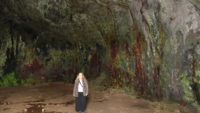 Many other historically important things happened at the castle, but enough of that. The castle has a cave! An awesome cave! An awesome fortified cave that looks over the tidal river! A cave that can only be reached by a spiral staircase! Awesome! The cave is really big, and was an important reason for why the castle was good at withstanding sieges. Boats with food could resupply the castle through the cave when the river was at high tide.
Many other historically important things happened at the castle, but enough of that. The castle has a cave! An awesome cave! An awesome fortified cave that looks over the tidal river! A cave that can only be reached by a spiral staircase! Awesome! The cave is really big, and was an important reason for why the castle was good at withstanding sieges. Boats with food could resupply the castle through the cave when the river was at high tide.
Mer and I clambered all over the towers and walls and keep and cave, and had a great time. We took two different docent-led tours just to hear more stories of the place. We left after six very happy hours to drive north to the southern part of Snowdonia National Park, a wild and mountainous part of northwestern Wales.
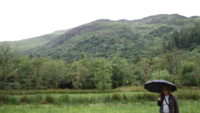 We got to our hotel at 7:00 and had supper just as the hotel restaurant was closing. Because Wales has a late sunset, we had some time after supper to walk five minutes over to a trailhead to take a hike. Mer suggested that maybe we shouldn’t do the five-hour, round-trip, strenuous hike up Cader Idris Mountain, so we did the twenty-minute easy hike along a stream, where we could admire hills and mountains all around us without actually having to climb any of them.
We got to our hotel at 7:00 and had supper just as the hotel restaurant was closing. Because Wales has a late sunset, we had some time after supper to walk five minutes over to a trailhead to take a hike. Mer suggested that maybe we shouldn’t do the five-hour, round-trip, strenuous hike up Cader Idris Mountain, so we did the twenty-minute easy hike along a stream, where we could admire hills and mountains all around us without actually having to climb any of them.
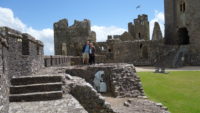 And so another day of touring is history. Tomorrow we will climb a mountain by sitting on a train, which seems a much easier way of going up in the world.
And so another day of touring is history. Tomorrow we will climb a mountain by sitting on a train, which seems a much easier way of going up in the world.